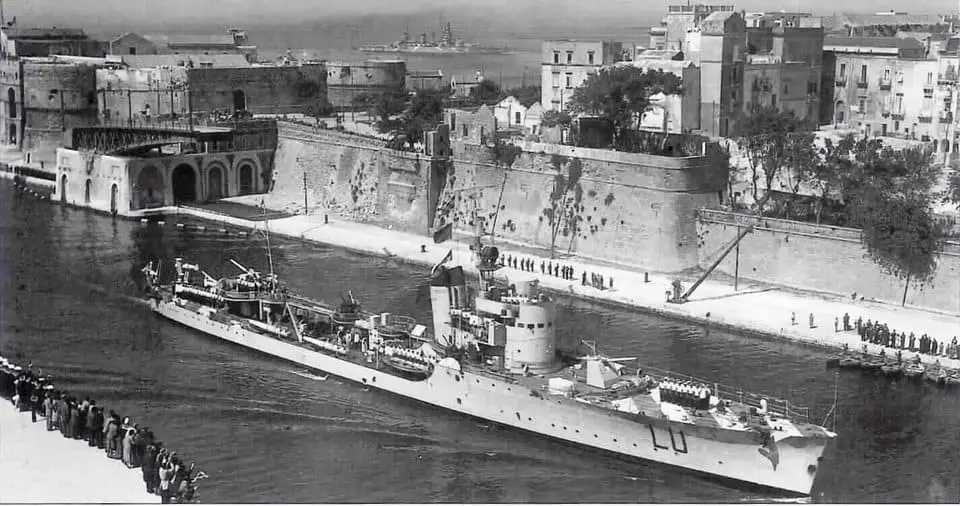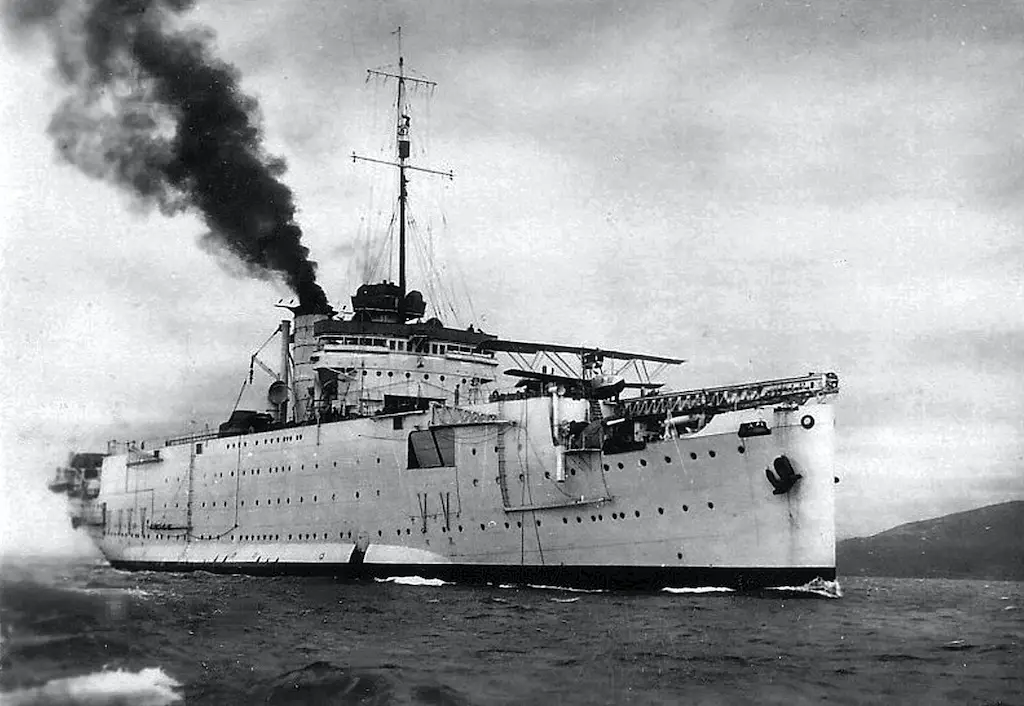Here are four brief stories of lesser-known vessels that deserve to be told.
RN Augusto Riboty

RN Augusto Riboty
The ship “Augusto Riboty” was one of the so-called “Explorers” of the Mirabello class, a type of ship that the Regia Marina used to build up until the early 1930s. Explorers were larger destroyers meant for scout operations in support of the battle fleet.
Entering into service in 1917, the Augusto Riboty managed to participate in 52 war missions during WW1. In 1938, the ship was downgraded to the destroyer level and in 1940 it was scheduled to be scrapped. But the war declaration to prolong its operational history.
The Riboty, capable of only 27 knots and lacking a fire control station, was relegated to convoy escort missions in the southern Adriatic Sea and subsequently in the Sicilian channel until 1943. In December 1940, during the disgraced campaign against the Hellenic country, it took part in the bombardment of Greek positions on the island of Corfu, together with other larger units.
The old ship incredibly survived the war, having accomplished 365 war missions. It was the most active Italian destroyer of World War Two.
RN Calatafimi

RN Calatafimi in a Greek port.
The Curtatone class RN Calatafimi was a destroyer of the Regia Marina built in the early 1920s. Due to its size and armament, it was downgraded to torpedo-boat in 1938. Armed only with 4x102mm guns and 6x450mm torpedo launchers, the Calatafimi is famous for its courageous “charge” against a French naval formation in June 1940 while under the command of Captain Giuseppe Brignole.
In the early hours of the 14 June 1940, the French cruisers Dupleix and Colbert together with 5 destroyers steamed towards Genoa to bombard the “Ansaldo” industrial plant. The Calatafimi was at sea for a mine laying operation and at 4:10 spotted the French formation. The commander decided to close the distance and engage the enemy under cover of the mist. The French bombardment of Genoa lasted 14 minutes until the gunfire from the Calatafimi and some coastal batteries interrupted the action. With increasing gunfire from two directions and not understanding exactly who was firing at them, the French squadron reversed course and sailed back to Toulon. The Calatafimi gave chase for a short while.
For this action, Captain Brignole was decorated with the Gold Medal for Military Valor. A few days later, a team from the Istituto Luce organized a re-enactment of the naval gun battle by filming the Calatafimi at sea, faking the clash that had taken place in the Ligurian sea. The Calatafimi spent the next three years performing escort, patrol and mine-laying missions until September 1943, when the Germans sized it the Piraeus port.
Renamed “TA-19” and manned with a German crew, the ship joined the 9th Torpedoboot-Flotille of the Kriegsmarine, operating in Eastern Mediterranean. The fate of the old Calatafimi was finally sealed in August 1944. It was torpedoed by the Greek submarine Pipinos in the Aegean waters. Five crew members died while the rest were rescued.
RN Lupo

A photo of Lupo following the clash with HMS Ajax, Orion and Dido. Note the damages to the hull.
The Lupo was a torpedo boat of the very much successful “Spica” class, which entered service in 1938. Unlike all the other major navies, the Regia Marina in World War Two made extensive use of Torpedo boats of various sizes. Some of them resembled earlier allied Destroyer escorts. In total, the Regia Marina built 32 ships of the Spica class. They were full protagonists of the naval war in the Mediterranean and used extensively in many different roles.
The Lupo was active in the Eastern Mediterranean, supporting the Italian operations against the Greeks and the British. In February 1941 it played a leading role in the recapture of the Island of Mégisti, near Rhodes, unloading troops and shelling the British positions.
However, the most famous action, for which the Lupo is remembered, is the night action between the 21st and 22nd of May 1941 during the Axis campaign against Crete. Under the command of Captain Francesco Mimbelli, the Lupo escorted a group of 21 gulets (wooden sailing vessels) transporting German troops destined to land on the shores of Crete.
At 22:33 the convoy sighted a ship steaming eastwards and crossing its route. The vessel sighted was the destroyer HMS Janus, part of Rear-Admiral Glennie’s squadron comprising the Cruisers Orion, Dido, Ajax and the destroyers Hereward Hasty and Kimberley. Lupo sighted the larger British formation a few minutes later.
Realizing the dire situation, Captain Mimbelli signaled the gulets to invert their course and sail back to Greece while he attempted an audacious attack against the British formation in order to delay the pursuit of the convoy. Approaching the enemy ships, the Lupo launched two torpedo salvos and then fired its guns at the British cruisers.
The attack of the Lupo surely caught Glennie’s formation by surprise and caused disorientation among the British. They reacted slowly and suffered from friendly fire. For instance, the Dido mistakenly fired 40mm shells at the Orion. Amid the confusion, the Lupo managed to cross the British squadron, inflicting minor damages and bringing disarray in the enemy camp.
However, the small torpedo boat was hit 18 times, suffering 2 dead and 26 wounded. Benefitting from the temporary disarray of Glennie’s formation, the Lupo managed to retreat, having consumed more than 70% of its ammunition and being heavily damaged.
Thanks to radar, the British squadron managed to intercept the slower gulets, sinking 10 of them and causing 800 casualties among the German troops. Hours later the Lupo came back to the site of the battle to save the survivors. For his action, Captain Mimbelli was awarded the Gold Medal for Military Valor while Lupo’s battle flag was decorated with the silver medal.
The Lupo met its fate in November 1942 south of the Kerkennah bank. It sank while providing assistance to the torpedo boat Veloce, previously hit by enemy aircraft. Under the cover of darkness, the destroyers of the British Force K approached the two Italian vessels and obliterated them with gunfire, leaving the Italians no time to react. Lupo and Veloce sank together with most of their crews.
RN Giuseppe Miraglia

RN Giuseppe Miraglia in 1939.
Another lesser-known vessel of the Regia Marina was the seaplane carrier “Giuseppe Miraglia”. Initially built as a civilian vessel destined to transport post and deliveries, the Regia Marina converted it into a seaplane carrier in 1925. It replaced the older ship “Europa”.
Carrying 20 seaplanes, mostly Macchi 25 and Ro.43, the ship participated as a support and transport vessel in the Ethiopian campaign of 1935–1936. It supported the Falangist forces during the Spanish Civil War. During World War Two, it supported the Italian fleet all along the 39 months of the war with its wing of recognizance aircraft.
Ultimately, it joined the Italian fleet in its surrender to the Allies in 1943. After 1945 it repatriated Prisoners of War held in Egypt and civilians from the former colonies in Libya and Dodecanese. It served until 1950 as a ship-barracks in Taranto until sold for scrap.
Sources:
Books and articles:
Riccado Nassigh “Le Battaglie Navali Italiane”, Delta Editrice (2011).
Giorgio Giorgerini “La Guerra Italiana sul mare”, Edizione Mondadori (2001).
Aldo Fraccaroli , “La notte della torpediniera Lupo”, Storia Illustrata n.136 (1969)
Websites:
Naval Encyclopedia – The Regia Marina
Marina Militare Italiana